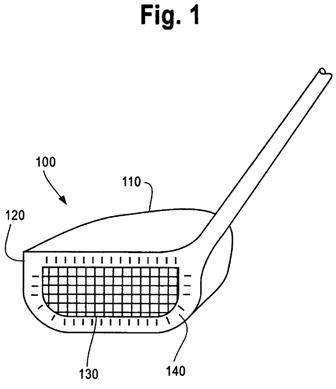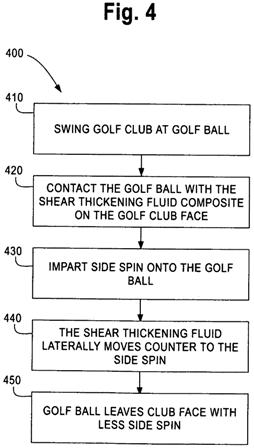Too Much Spin From Your Driver? This May Be the Answer
Over the years I have posted several times about how inventors have attempted to reduce the spin produced with a driver. Generally these attempts center around the application of a lubricant to the face of the golf club (see this post, or this post ). That’s not cheating!
A recently published patent application discloses a new spin at reducing spin. The application published as US Pub. No. 

[0002] A shear thickening fluid (also known as a dilatant fluid) is a fluid that increases in apparent viscosity as the rate of shear increases. This is in contrast to a Newtonian fluid (such as water) where the amount of shear rate achieved is directly proportional to the shear stress applied and the proportionality constant is the viscosity, where the viscosity does not vary over different shear rates. Thus, a shear thickening fluid is a non-Newtonian fluid where the shear stress is not directly proportional to the shear rate applied and where the apparent viscosity actually increases with higher shear stresses. At high enough shear rates the fluid becomes highly rigid. A shear rate may be defined in terms frequencies as measured in Hertz, or per second. In this manner, the higher the shear rate, the higher the frequency. Thus, by tuning the frequency response of the shear thickening fluid, the material may be programmed to display dilatants behavior at low or high frequencies. The rate of shear is simply the velocity of the object of the interest divided by the displacement of the object. Thereby, if the shear rate of the object of interest is known, a shear thickening fluid’s response frequency may be tuned to its complement. A composite utilizing a shear thickening fluid may also be tuned to become rigid at a desired frequency. This tuning may be performed in particulate based shear thickening composites by altering the concentration of particles. Low particle concentrations demonstrate a higher frequency solid response while remaining fluid at lower frequencies. High particle concentrations demonstrate lower frequency response and thus become solid at lower shear rates.
[0003] This behavior is caused by the interactions between the particles and liquids in the fluid. Typically, at low shear rates a shear thickening fluid fills gaps between particles with liquid that acts as a lubricant and reduces the friction between the particles. However, at higher shear rates the liquid does not fill these gaps and the lack of a lubricant increases the friction between the particles and thereby causes an increase in apparent viscosity in a shear thickening fluid. There is also a jamming effect, whereby particles have less time to rearrange upon application of shear if the rate of shear exceeds the diffusion rate of the particles.
[0004] A useful result from these shear thickening fluid properties is when a shear stress is applied to a shear thickening fluid, the applied shear stress causes the shear thickening fluid to turn more solid-like and becomes more rigid. As soon as this shear stress is taken away, then the shear thickening fluid returns to its normal flexible resting state.
.
.
.
[0008] Turning now to golf, many people enjoy the game of golf. Often times, golfers hit a golf ball squarely to create a straight shot–where the club face is perpendicular to the desired straight path upon impact with the golf ball causing the ball to go straight. Unfortunately many amateur golfers struggle with trying to hit shots that go straight but are often unsuccessful. Often times, golfers who do not hit the ball straight find that a non-straight shot takes distance away from their shot and may leave their ball in an undesirable location such as behind a tree, inside a sand bunker, or in a water hazard. Often times this off-course path taken by the golf ball is caused by side spin imparted on the golf ball at impact. This side spin creates a lower zone of pressure on the side of the ball in which the ball is rotating while higher pressure occurs on the side of the ball away from the rotation, causing a pressure differential to push the ball in the direction of the spin as explained in Bernoulli’s principle. This pushing thus causes the ball to veer away from a straight path.[0009] This side spin is created in several different ways. For instance, when the golf club head is “open”–when the heel of the club head is in front of the toe of the club head and the ball is not hit squarely–the club head side of the club face hits the near side of the ball first, imparting a spin from left to right for a right-handed golfer (it is opposite for a left-handed golfer) causing the golf ball to curve to the right during its flight path, or slice. A slice may also be created when a club head path goes from outside in, no matter how squarely the ball is hit, because the club-path motion still imparts the left to right spin on the golf ball. A hook is the opposite of the slice. One way a hook occurs is when the toe side of the club face hits the far side of the ball first, imparting a right to left spin for a right-handed golfer (it is opposite for a left-handed golfer) causing the golf ball to curve to the left during its flight path. Similar to a slice, a second way a hook may be created is when the club head path goes from the inside out–even if the club face impacts the ball squarely–imparting the right to left spin which causes the golf ball to hook left.
.
.
.
[0019] One or more of the embodiments of the present invention provide for improved athletic performance with the use of shear thickening fluids. Hitting a golf ball with a golf club face composed of a shear thickening fluid composite reduces the side spin imparted on a golf ball when the golf club face does not hit the golf ball squarely. Upon impact, the shear thickening fluid within the composite shifts laterally and inhibits side spin by deforming and making the impac
ted objects (club face and golf ball) impact planes more parallel, which reduces the amount of slicing or hooking. Post-impact and deformation, the composite becomes elastic/solid and transfers the remaining energy of impact between the club face and the ball. Using a shear thickening fluid composite for a golf ball cover also has the same effect of reducing the side spin imparted onto the golf ball.
Definitely a cooler way to deal with spin than smearing lip gloss on the face of your driver!
Dave Dawsey – The Golf Lawyer
